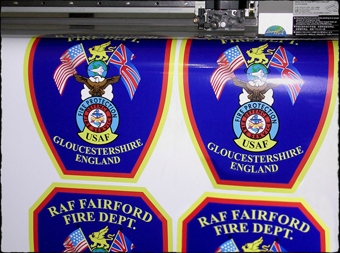Larry Chan has been involved in the sign industry since 1997—all sixteen of these years as a one-man sign-making band. Chan is the owner and sole employee of Signs and Prints, a print specialty company located in a dedicated 600-square foot dedicated space of his home in East Weymouth, Massachusetts.
Chan started in the industry by doing basic designs on his vinyl cutter for some of his friends, and this grew into the need to set up a plotter to do more detailed designs and higher-end vinyl decals and lettering. He eventually graduated into wide format printing using a Roland Hi-Fi JET FJ-540 inkjet printer and VersaCAMM SP-300 30-inch and VS-540 54-inch printer/cutters, and his clients are extremely happy he did so.
Signs and Prints is using digital printing technology to produce signage, banners, window, wall and floor graphics, garment designs, packaging labels, vehicle graphics, and anything else his customers need to market their businesses. Chan mostly uses Eco-Sol MAX inks to output onto a variety of media—vinyls, artists’ canvas, backlit, banners, satin photo papers, reusable materials, and magnetic media. (Note: For reproducing photographs, Chan will instead employ pigment inks.
To further simplify production (since he is a one-man shop), Chan will utilize his printers’ media take-up system to print while he handles an installation or consults with a customer.
One demographic Chan caters to (and identifies with!) is small business owners—bakeries, restaurants, and retail shops that change their displays and P-O-P frequently. Chan uses his wide format set-up to help them compete with the “big boys.”
Chan finds that one advantage working with small businesses clients is that they allow him a free rein at coming up with design ideas. (Note: Chan has always liked to draw and design.) “You don’t have to wait for approval from the corporate office,” he explains, “so I can just go ahead and get started on designs.”
Chan also does lettering and insignias for lots of fire department trucks across the country. These decals range in size from fourteen inches to sixteen inches tall, and he’ll typically print them onto Avery and Oracal reflective vinyls.
This type of work started soon for him after the events of 9/11. “I did fundraising decals for the fire department in nearby Braintree, Massachusetts and became friends with them,” says Chan, noting that their word of mouth and exposure has led to other people and fire departments emailing him for quotes and sign work.
When he receives the artwork from a fire department or creates it from scratch, Chan will import and redraw it in Illustrator®. “Sometimes they’ll send me an actual emblem or patch, so I’ll scan it in and then redraw it with an overlay on top,” he says.
Chan finds that 300-dpi works best for printing out the decals, although he can work with smaller resolutions. When drawing the emblem or artwork in Illustrator, Chan finds it best to design it as an EPS vector-base graphic or Illustrator native file. “This way they won’t distort when I enlarge them,” he says. (Note: If the client sends him a raster-based JPEG file, then he specifies to them that it has to be in a high resolution.)
Chan feeds the cut line and outline he created in Illustrator to his VersaWorks™ RIP software that then cuts out the letters or the contour shapes in any color and any design.
{2j_imageviewer 51}
His work here has led him to also serve military and firefighting members stationed overseas in Afghanistan and Iraq. These typically involve magnets and vinyl decals for their EMS trucks. “They’ll send me a picture of their logo or patch, and I’ll set up the design, print them out, and ship them back via Priority Mail to their APO military address,” he says.
Chan mostly print the graphics directly onto the magnet. However if a reflective appearance is requested, he’ll print onto the reflective vinyl and apply it to the magnet blank.
Signs and Prints has found even more success expanding beyond small businesses and the military. Chan has been producing red carpet backdrops for fashion shows and charity events over the past six years. He became involved with this market when a couple of his friends who own a modeling agency in the Boston area referred him to fashion designers needing backdrops for events like Fashion Week in Boston and New York City. “These are mainly ‘step and repeat’ graphics, where the sponsor logo is repeated throughout the fabric,” explains Chan, noting that he prints directly onto the fabric materials (which is “like printing onto any other media like paper and vinyl”).
Chan finds that shear-type vinyl is harder to print on because they sometimes don’t come with liner and masking paper. “Because it’s so thin and so soft, it tends to curl up from the pinch rollers,” he says.
To help this process, Chan just lets the fabric material come down first and then feeds it through the pick-up roller. “The pick-up roller applies the tension to it to keep it nice and taut as it feeds through the printer,” he details.
Thanks to his successes here, Chan plans to offer his clients products for residential interior décor and fabric printing in the future.
Chan prices his printed signs and graphics based on square footage and then adds in the costs of ink and materials, as well as time and labor, into a final quote for the customer. Naturally he’ll charge more for fabrics than cheaper calendered vinyls. However he’s found that, although metallic vinyls are also priced higher than calendared and cast vinyls, they’re easy for him to upsell. “Some customers will actually come to me after seeing them on someone else’s truck,” he says. “Or maybe they want a chrome or a gold or a silver carbon fiber. They’re willing to pay for it.”
—Jeff Wooten











